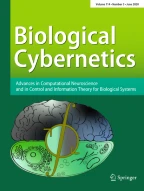Abstract.
In a stereoscopic system, both eyes or cameras have a slightly different view. As a consequence, small variations between the projected images exist (`disparities') which are spatially evaluated in order to retrieve depth information (Sanger 1988; Fleet et al. 1991). A strong similarity exists between the analysis of visual disparities and the determination of the azimuth of a sound source (Wagner and Frost 1993). The direction of the sound is thereby determined from the temporal delay between the left and right ear signals (Konishi and Sullivan 1986). Similarly, here we transpose the spatially defined problem of disparity analysis into the temporal domain and utilize two resonators implemented in the form of causal (electronic) filters to determine the disparity as local temporal phase differences between the left and right filter responses. This approach permits real-time analysis and can be solved analytically for a step function contrast change, which is an important case in all real-world applications. The proposed theoretical framework for spatial depth retrieval directly utilizes a temporal algorithm borrowed from auditory signal analysis. Thus, the suggested similarity between the visual and the auditory system in the brain (Wagner and Frost 1993) finds its analogy here at the algorithmical level. We will compare the results from the temporal resonance algorithm with those obtained from several other techniques like cross-correlation or spatial phase-based disparity estimation showing that the novel algorithm achieves performances similar to the `classical' approaches using much lower computational resources.
Similar content being viewed by others
Author information
Authors and Affiliations
Additional information
Received: 9 April 1997 / Accepted in revised form: 15 January 1998
Rights and permissions
About this article
Cite this article
Porr, B., Cozzi, A. & Wörgötter, F. How to “hear” visual disparities: real-time stereoscopic spatial depth analysis using temporal resonance. Biol Cybern 78, 329–336 (1998). https://doi.org/10.1007/s004220050437
Issue Date:
DOI: https://doi.org/10.1007/s004220050437
